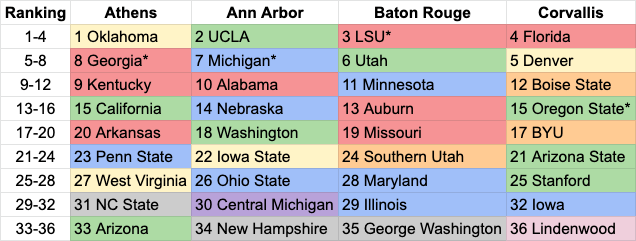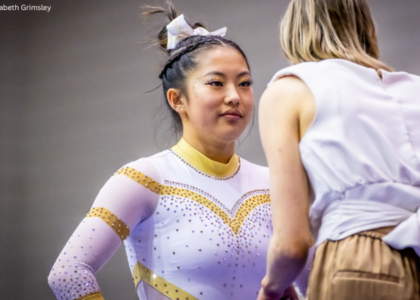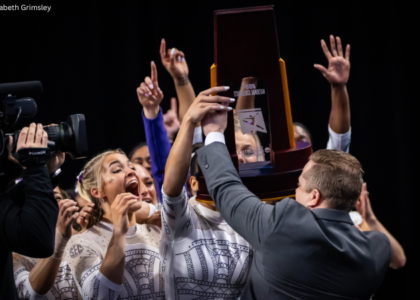The revised “Four on the Floor” format of the 2019 postseason delivered on the promise of drama and was largely well-received by fans. However, a major change like this is bound to have a few pain points. Here are four potential changes that would improve the postseason experience for fans, as well as increase fairness for the competitors.
Reorganize the Distribution of Teams to Regionals
The NCAA’s criteria for placing teams within the bracket is to seed teams ranked 1 to 16 in a snake-style bracket, allowing changes only for host teams conflicts, and to add teams ranked 17 to 36 to each regional primarily based on geography while also making an effort to avoid conference rematches as much as possible.
While attempting to limit travel costs for athletic programs is a worthy undertaking, the bracket released following conference championships had many head-scratching pairings that showed the NCAA did not take teams’ actual rankings into consideration. For example, why was No. 17 BYU, the top team available once seeds 1 to 16 were placed, not given geographical preference over lower-ranked teams? Instead of a relatively short journey to Corvallis, the team was assigned to Baton Rouge. Of course it’s impossible to send every team ranked between 17 and 36 to its closest regional, but higher-ranked teams should be rewarded for their regular season success or there won’t be an incentive for teams to improve their ranking once it becomes clear they’ll finish outside the top 16.
Another way to reward a team for its regular season ranking is to ensure a more equitable distribution of strong teams within each regional. To continue with the Baton Rouge regional example, let’s take a look at No. 20 Arkansas. In a true snake-style bracket, Arkansas would have been the fifth-seeded team within its regional and the third-highest-ranked team within its regional semifinal. Instead, No. 17 BYU was assigned to the same regional, leaving Arkansas as the sixth-seed and the lowest-ranked team in its regional semifinal, making it much harder to advance to the final. Meanwhile, No. 23 Penn State, who would have been ranked eighth among the teams in the Baton Rouge regional, was the fifth-seeded team in the Ann Arbor regional. It’s clear that the NCAA did not take ranking into account with this group of teams, with the exception of determining which teams would be sent to play-in match-ups.
Instead, once teams ranked No. 1 to No. 16 are arranged in the bracket, take teams ranked 17 to 20 and send one to each regional, taking geography into account where possible while also trying to avoid too many teams from one conference being sent to the same regional. Then do the same with the next set of four teams and so on, until the bracket is complete. Here is how this would have looked in 2019. Note: Regional hosts are indicated with an asterisk (*) and background color indicates the team’s conference.

This is just one possible arrangement, but it minimizes the number of conference foes in a regional to just three—compared to the five Big Ten teams that competed in Ann Arbor—while taking both team ranking and geography into account.
Rearrange the Regional Semifinal Match-ups
The issues with team distribution were compounded by the strange way the NCAA chose to arrange the regional semifinal match-ups. Instead of a snake-style distribution of seeds 1, 4, 5, 8/9 and 2, 3, 6, 7, the NCAA elected to match up the teams seeded 1, 4, 7, 8/9 and 2, 3, 5, 6. While this method certainly rewarded the top seeded team in each regional with an easy path to advancement to the regional final—a longstanding goal of the NCAA—it also gave the fourth-seeded team a much easier path than the second- and third-seeded teams. It also made the sixth-seeded team (such as Arkansas at the Baton Rouge regional) the bottom-ranked team in its regional semifinal, making it much more difficult to pull off an upset.
If a snake-style distribution were used with the bracket proposed above, these would be the regional semifinal match-ups:
Athens semifinal one: No. 8 Georgia, No. 9 Kentucky, No. 23 Penn State, No. 27 West Virginia
Athens semifinal two: No. 1 Oklahoma, No. 15 California, No. 20 Arkansas, winner of No. 31 N.C. State and No. 33 Arizona
Ann Arbor semifinal one: No. 7 Michigan, No. 10 Alabama, No. 22 Iowa State, No. 26 Ohio State
Ann Arbor semifinal two: No. 2 UCLA, No. 14 Nebraska, No. 18 Washington, winner of No. 30 Central Michigan and No. 34 New Hampshire
Baton Rouge semifinal one: No. 6 Utah, No. 11 Minnesota, No. 24 Southern Utah, No. 28 Maryland
Baton Rouge semifinal two: No. 3 LSU, No. 13 Auburn, No. 19 Missouri, winner of No. 29 Illinois and No. 35 George Washington
Corvallis semifinal one: No. 5 Denver, No. 12 Boise State, No. 21 Arizona State, No. 25 Stanford
Corvallis semifinal two: No. 4 Florida, No. 15 Oregon State, No. 17 BYU, winner of No. 32 Iowa and No. 36 Lindenwood
Move the Play-ins to the Previous Weekend
The addition of the play-in round to the regional championships has the potential to be exciting, but the execution in the 2019 postseason was flawed. In the current format, the play-in round is conducted on Thursday afternoon to give the qualifying team and individual gymnasts enough time to rest before competing again on Friday and potentially on Saturday as well. While it’s easy to argue that it’s unlikely a play-in team would ever qualify for the Saturday regional final, a team who struggles during the regular season but surges late—exactly like Illinois did in 2019—could absolutely pull off an upset and qualify to the regional final. But why have the possibility of a team competing three days in a row at all?
In 2019 there were no women’s meets scheduled the weekend in between conference championships and regionals. Moving the play-ins to this weekend would allow these lower-ranked teams to have the spotlight entirely on them, and it would allow fans to see these exciting duals outside of working hours. All four match-ups could take place in one location to not only entice fans to come see six hours of exciting gymnastics but create yet another opportunity for a school to host a postseason competition. This would eliminate the possibility of a team having to compete three days in a row while still ensuring the advancing teams have plenty of rest before regionals the following weekend.
Yet another benefit of moving the play-in round to the weekend prior is that it would allow more individuals from non-qualified teams to compete at regionals. In 2019, athletes from all the play-in teams were included in the list of qualified individuals, even though many of them ended up competing in the regional semifinals as part of a team. Determining the individual qualifiers after the play-in round would open up several spots to athletes who would not qualify under the current format.
Allow More Individuals to Qualify to Nationals
In 2018, 138 athletes competed on at least one event during the national semifinals, the competition that determined individual champions and All-Americans. This included 39 athletes who competed in the all around. In 2019 with the new postseason format, those numbers dropped to 104 and 21, respectively. There are two reasons for this: the reduction in the number of full teams from 12 to eight, and the reduction in the number of individual all around qualifiers from 12 to four. The reduction in the number of all around qualifiers was presumably done because there were fewer teams for them to rotate with at nationals, but it would be in the best interest of the sport to allow more all arounders to compete. The top-ranked all arounders who were missing from the competition in 2019 were No. 5 Trinity Thomas (Florida), No. 16 Mollie Korth (Kentucky), No. 18 Shannon Evans (BYU) and No. 20 Cairo Leonard-Baker (Arizona State). Thomas and Leonard-Baker qualified on individual events but could not compete all four at nationals. Three of these four gymnasts—Thomas, Korth and Leonard-Baker—would have qualified in the all around if three gymnasts were allowed to advance from each regional instead of one.
Another pain point for individual qualification to nationals is the complexity of the tie-breaking rules. Many fans would like to do away with the rules entirely to allow more gymnasts to compete at nationals. One notable victim of a tiebreaker in 2019 was gymternet favorite Sophia Hyderally (Alaska), who would have qualified on beam if all individuals with the top score were to advance. This robbed her of the opportunity of becoming the first gymnast from her school to ever qualify to nationals. While the team competition is deservedly the main focus of nationals, allowing more individuals to compete would give the opportunity to reward gymnasts such as Hyderally for incredible seasons that go largely unnoticed among fans and media.
BONUS: Unrealistic but Fun-to-Think-About Changes
Wouldn’t it be nice if the NCAA brought back event finals at nationals? You could argue that there is a disconnect in the rules for the team and individual competitions on the semifinal day. In the team competition, the top two squads from each session advance to the final rather than combining the scores from both sessions to determine the top four teams. This seems like the NCAA is admitting that the scores from the two sessions are not directly comparable, so why isn’t the same logic used for the individual competition? The return of event finals would not only be exciting for fans but would also ensure fairness in the competition.
Second, the NCAA should consider combining men’s and women’s nationals into one large event. In 2019, both competitions were scheduled simultaneously, which meant fans had to choose which competition to attend or watch on TV. This conflict is scheduled to continue through at least 2022. Given the state of men’s collegiate gymnastics, it seems unfair to those teams and individuals to schedule their championship at a time when much of the fan base would be unable to attend. Combining the two championships would allow for more rest time for the athletes, more exposure for men’s gymnastics and more incentive for fans to travel to see the excitement and drama. If this isn’t an option, the NCAA should at the very least adjust the schedules so that the championships aren’t in direct conflict with one another.
Article by Jenna King
Like what you see? Consider donating to support our efforts throughout the year!





2 comments